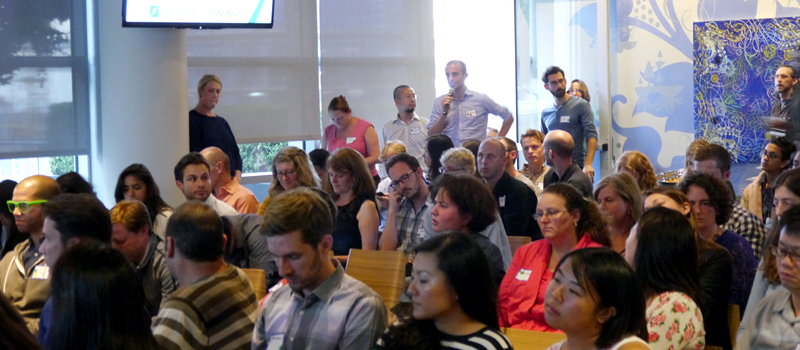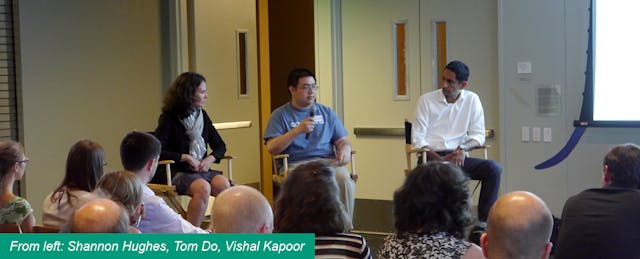One can argue that MOOC-mania peaked in 2012, which The New York Times famously called “The Year of the MOOC.” Variants of the word “disruption” appeared three times in that article, portending a momentous transformation in how students learn and how teachers teach.
A year later, the The New York Times acknowledged setbacks. That early results did not live up to lofty expectations were perhaps not so surprising. High-profile, humbling lessons from initial pilots like those at San Jose State University led many to curb their enthusiasm.
Today, the debate rages on: Are MOOCs a success or failure? Most of the conversations tend to focus on a couple key points--completion rates (and by association, dropout rates) and grades. While these are typical measurements of student success, what is often missing in these discussions is the wealth of other data that offers insights into other impacts and trends.

At EdSurge’s July SF Edtech Meetup, we invited Vishal Kapoor (Marketing at Vocareum), Chuong (Tom) Do (Software Engineer and Analytics Lead at Coursera) and Shannon Hughes (Senior Director of Marketing at Udemy) to share data and insights that help us appreciate the potential--and progress--of online learning and MOOCs from different perspectives.
Can’t Even Start
Something that often gets lost in the “learn to program” craze is the complicated task of setting up a proper coding environment. For many students, getting properly set up to do coding exercises proves to be much more difficult than learning to code itself.
This is one of the most significant barriers for instructors who teach programming MOOCs, according to Kapoor. According to his interviews and research, 30% of a student’s time in a MOOC is spent managing the coding environment that they’re working on. “And this 30% number is for people who finish the class,” he shares.
“The ones who don’t finish the class cite this as one of the main reasons...They go, ‘Hey this is Week Two, I was still figuring out what this Eclipse [a Java development environment popular in coding classes] is, and so I just gave up.”
Technology can help instructors scale their reach and impact without changing the nature of how they teach, says Kapoor. “The teachers don’t need any additional skills--the more pedagogical aspect is already there. It’s about giving them the ability to scale...and having visibility to know what’s going on with every student and be able to see trends into what parts of the course are working--or not.”
Who’s Taking MOOCs?
Do offered a tour through the demographics of Coursera’s eight million (and counting) users, beginning with a basic question: What is the population of Coursera like? Currently, it’s “predominantly adult learners,” he says, adding that over half of its users have a four-year degree and a full-time job.
Do also dove deeper into global trends of Coursera students, sharing data about:
Democracy: “The less democratic a country is [according to The Economist’s 2012 Democracy Index], there’s a higher interest in democracy courses.”
Age distribution trends across different subjects: “It seems when you’re young you think machine learning is all important, but a little bit later in life statistics is something you forgot to take. Perhaps when you’re a bit older poetry is something you really need to appreciate, as is philosophy.”
Gender bias in different subjects: The percentage of females taking classes on different subjects “seems to reinforce stereotypes with regard to which classes are ‘more male’ or ‘more female.’” For instance, females make up the majority of students in classes on Food and Nutrition, Teacher Professional Development and Medicine. But they make up less than 20% of students in computer science and engineering.
(The graphs that follow are re-posted from Coursera.)


With this robust data about who is taking courses, Do says Coursera hopes to be able to “use information from our audience segmentation in order to personalize the experience for different learners.” He adds that Coursera is seeing an upward trend in female representation in terms of overall users, as well as in emerging markets.

Learning Never Ends
“Working and learning happen at the same time,” say Hughes. “The vast majority of those learning on Udemy are working professionals who are trying to keep their skills current.”
Citing reports from the U.S. Department of Labor, McKinsey and Company, and the World Economic Forum, Hughes offered statistics suggesting a mismatch between what kids are learning and what skills future jobs will require:
- 65% of grade-school kids will have jobs that don’t exist today;
- 72% of education institutions say recent graduates are ready for work; only 42% of employers agree.
“This traditional model of learning in a school and working at work is disappearing,” says Hughes. Like many of Coursera students, the majority of Udemy’s three million users in over 190 countries look to the online learning marketplace to re-tool themselves in anticipation for new jobs and futures.


